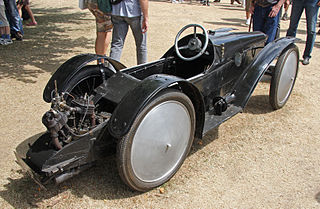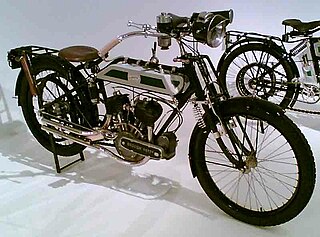History
The first model, the Carette was a three-wheeled cyclecar with a side-valve, water-cooled Crouch V-twin engine of 740 cc mounted behind the seats. It was of unconventional appearance with a low, wide radiator. The chassis frame was of ash with metal armouring and the drive was to the single rear wheel via a three-speed gearbox and chain. It cost around a £100 and was claimed to be capable of 35 mph (56 km/h) and 50 miles per imperial gallon (5.6 L/100 km; 42 mpg‑US). Later in 1912 it was also available as a four-wheeler with the engine enlarged to 906 cc. In 1913 it grew to 994 cc and in 1914 to 1018 cc. One of the cars gained a Gold Medal in the 1912 London-Exeter trial. When production restarted after the war the model became known as the 8 with the engine now displacing 1115 cc. The last one may have been made as late as 1922 when it cost £245.

A cyclecar was a type of small, lightweight and inexpensive car manufactured in Europe and the United States between 1910 and the early 1920s. The purpose of cyclecars was to fill a gap in the market between the motorcycle and the car.

A flathead engine, otherwise sidevalve engine, is an internal combustion engine with its poppet valves contained within the engine block, instead of in the cylinder head, as in an overhead valve engine.
In 1922 a more conventional car came along, the 8/18, still a two-seater and dickey, with pressed steel chassis and shaft drive. The V-twin engine was retained, however, but now with overhead-valves and 1248 cc capacity. It was listed at £285. About 1500 V-twin cars are thought to have been made after the First World War and possibly 400 before 1914.
With other manufacturers offering four-seat cars at less money it was necessary for Crouch to change and in 1922 the 12/24 was announced at £350 for a four-seater and £335 for a two-seater with four-cylinder Anzani 1496 cc engine and three-speed gearbox. An electric starter was fitted. A 60 mph (97 km/h) Sports and 80 mph (130 km/h) Super Sports were listed and one of these were raced at Brooklands by Alfred Moss, the father of Stirling Moss, who sold the cars from his London premises. About 800 12/24s are thought to have been made.

Anzani was an engine manufacturer founded by the Italian Alessandro Anzani (1877–1956), which produced proprietary engines for aircraft, cars, boats, and motorcycles in factories in Britain, France and Italy.

Brooklands was a 2.75-mile (4.43 km) motor racing circuit and aerodrome built near Weybridge in Surrey, England, United Kingdom. It opened in 1907 and was the world's first purpose-built motor racing circuit as well as one of Britain's first airfields, which also became Britain's largest aircraft manufacturing centre by 1918, producing military aircraft such as the Wellington and civil airliners like the Viscount and VC-10.

Alfred Ethelbert Moss was an English dentist and racing driver.
The cars were still expensive, and so in 1923 the Economic 10/4 10 hp model was announced at £250, using a four-cylinder Dorman side-valve engine of 1200 cc. It was not terribly successful and only about 60 were made.
W.H. Dorman & Co Ltd was a company formed by William Henry Dorman in 1870 making cutting tools for the footwear industry. It diversified into other tools including grinders, and in 1903 into internal combustion engines. This was to be its main product up to the point where it was taken over by the English Electric Company in 1961, though the Dorman name continued as a diesel engine trademark until 1995. William Henry Dorman retired in 1911, and died in 1926.
For 1925 the 12/24 became the 12/30, the Economic vanished and what was to be the final car the 11/27 was announced. This had a 1368 cc Coventry Simplex four-cylinder side-valve engine and was priced between £225 and £285. About 100 11/27s were made.
The company disappeared with many others as a result of the Great Depression, and the rise of mass-produced small cars which could comfortably undersell the largely hand-built small-makers models. A failed export order did not help.
Of the approximately 3000 cars made, only about five are known to have survived.
At its peak Crouch employed about 400 people and turned out 25 cars a week. John Crouch, the founder, had trained with Daimler, and his son Bob worked there after the family firm closed. He eventually became head of bus sales.
Crouch Cars of England had no connection with Crouch of New Brighton, Pennsylvania, USA, who manufactured steam cars between 1897 and 1900.

Berkeley Cars Ltd of Biggleswade, Bedfordshire, England produced economical sporting microcars with motorcycle-derived engines from 322 cc to 692 cc and front wheel drive between 1956 and 1960.
The Adamson was an English car manufactured in Enfield, Middlesex, from 1912 to 1925. It was designed by Reginald Barton Adamson at the premises of the family haulage contract business.

The Arab was a high-performance English automobile designed by Reid Railton and manufactured in Letchworth, Hertfordshire, between 1926 and 1928. The factory had previously been used by the Phoenix car company.

Argyll was a Scottish motor car marque manufactured from 1899 to 1932, and again from 1976 to around 1990.

Singer Motors Limited was a British motor vehicle manufacturing business, originally a bicycle manufacturer founded as Singer & Co by George Singer, in 1874 in Coventry, England. Singer & Co's bicycle manufacture continued. From 1901 George Singer's Singer Motor Co made cars and commercial vehicles.

Morgan 4/4 is an automobile which has been produced by the Morgan Motor Company since 1936. It was Morgan's first car with four wheels, the name indicating that the model has four wheels and four cylinders. Early publicity and advertising material variously referred to the model as "4/4", "4-4", "Four Four" and similar names, but from the outset the factory designation was always "4/4".
The Lanchester Motor Company Limited was a car manufacturer located until early 1931 at Armourer Mills, Montgomery Street, Sparkbrook, Birmingham, and afterwards at Sandy Lane, Coventry England. The marque has been unused since the last Lanchester was produced in 1955. The Lanchester Motor Company Limited is still registered as an active company and accounts are filed each year, although as of 2014 it is marked as "non-trading".

Brough Motorcycles were made by William E. Brough in Nottingham, England, from 1902 to 1926, after some earlier experimentation with motorised tricycles. The Brough Superior company was a separate company created by his son, George Brough.

Albion Motors was a Scottish automobile and commercial vehicle manufacturer.

Coventry Premier Limited owned a British car and cyclecar manufacturing business based in Coventry from 1912 to 1923. It changed its name from Premier Cycles to Coventry Premier Ltd in November 1914.

The Riley Nine was one of the most successful light sporting cars produced by the British motor industry in the inter war period. It was made by the Riley company of Coventry, England with a wide range of body styles between 1926 and 1938.
The Rover 8 was a small single-cylinder eight-horsepower 1327 cc car made by the British Rover car company. It was Rover's first production car. It was remarkable for being supported by a backbone chassis rather than a conventional ladder frame. The first model was manufactured from 1904 to 1912, A Daimler-Knight sleeve-valve engine option was available in 1911 and 1912.
Egon Brütsch Fahrzeugbau, usually shortened to Brütsch, was a German automotive design and automaker based in Stuttgart, Baden-Württemberg.

The Lancia Trikappa is a passenger car produced by Lancia between 1922 and 1925. It was a luxury car, the flagship of Lancia's production. The Trikappa 4.5-litre V8 is notable as the first of Lancia's narrow V engines, a distinguishing feature the manufacturer only abandoned in the 1970s. The car was offered as a bare rolling chassis, as torpedo or 6-seater coupé de ville. In total 847 were manufactured.

ABC motorcycles was a British motorcycle manufacturer established in 1914 by Ronald Charteris in London. Several British motorcycle firms started up with the name "ABC", including Sopwith. The All British Engine Company Ltd. of London was founded in 1912 and later changed to ABC Motors Ltd. With chief engineer Granville Bradshaw, Charteris built a range of engines throughout the First World War. From 1913 ABC produced motorcycle engines.

The Rover 12 was a name given to several medium-sized family cars from the British Rover car company between 1905 and 1948.
The Marlborough was a make of car sold on the British market between 1906 and 1926. For most of its life the cars were made by Malicet et Blin in France, but after World War I they were partially assembled (finished) in London and an increasing number of British parts used.

The Warren-Lambert Engineering Co. Ltd. was a British automobile manufacturer that was established from 1912 to 1922 in Richmond, then in Surrey. A. Warren Lambert, was an agent for Morgan cars in Putney which he also raced. In 1912 he designed and started to manufacture a two-seat four-wheel cyclecar from premises in Uxbridge Road, Shepherd's Bush. It was well received and around 25 cars a week were being made.
The Singer Ten name was used for several automobiles produced by Singer Motors between 1912 and 1949. The "Ten" in the name referred to the taxation horsepower rating in the United Kingdom.

The Alvis 10/30 is a car introduced by British car maker Alvis Car and Engineering Company Ltd in 1920. It was the company's first production vehicle and was made until 1923. A range of body styles was available.





















